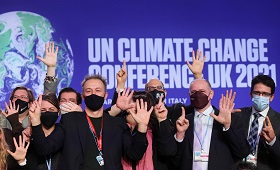From November 6 to November 20, 2022, the 27th Conference of the Parties (COP-27) to the United Nations Framework Convention on Climate Change (UNFCCC) was held in Sharm el-Sheikh, Egypt, with over 30 thousand delegates from almost 195 states present. At the opening ceremony UN Secretary-General António Guterres warned world leaders that “we are on a highway to climate hell”. He made it clear that either the conference would end with a signed climate solidarity pact, or a collective suicide pact. At the center of the summit was a proposed “loss and damage” fund, which would help developing countries deal with climate change. However, more needs to be done to tackle the threatening changes seen in the global climate.
An Unfavorable Context for Climate Diplomacy
Last year’s COP-26, held in Glasgow, Scotland, marked five years since the signing of the Paris Agreement (one year had to be skipped due to the COVID-19 pandemic). The Glasgow Climate Pact was the major result of the conference; it reaffirmed that the world’s main goal is to keep global warming within 1.5°C. Moreover, many decisions were made in the field of energy. For example, over 40 countries agreed to abandon the use of coal by 2030, and many states also pledged to strive for carbon neutrality. Xi Jinping and Vladimir Putin said they would ensure carbon neutrality by 2060. However, already by May, mothballed coal mines began to reopen in Europe to replace Russian gas and coal.
Back in March of this year, American environmentalist and journalist David Wallace-Wells said that it was almost impossible to achieve the results announced by the Paris Agreement in time: “Any delay makes the goal of keeping global warming at 1.5°C unattainable. And there will be postponements”. A similar viewpoint was shared in the 2022 Emissions Gap Report issued by the UN Environment Program in late October, prior to COP-27. The report reaffirmed that given the current difficult conditions, the goal seemed to be out of reach.
The climate conference in that took place in Egypt this year, happened amid a complex geopolitical situation. With the Western states being at loggerheads with Russia and unprecedented military aid being delivered to Ukraine, the world had to drastically switch from conflict to climate related issues, which also requires millions of dollars. Therefore, the preconditions for each nation to take on new money-consuming commitments were unfavorable. However, the final agreement of last year’s summit contained a pledge to increase financial assistance to poor and developing countries to combat climate change. This issue also appeared at the top of COP-27’s agenda.
Negotiations to Implementation: What Was at the Heart of the COP-27 Agenda?
According to a statement made by the then Chairman of COP-27, Egyptian Foreign Minister of Sameh Shoukry, the summit was devoted to moving away from negotiations, and to the implementation of the commitments made in Glasgow. Egypt, the host country of the conference, called for full, timely, comprehensive, and ambitious on-the-ground action.
The talks were centered around three major topics: mitigation of greenhouse gas emissions, adaptation to climate change and assistance to others, and climate finance. In regards to mitigation, countries were expected to demonstrate how they plan to review their goals and create a roadmap related to climate change mitigation. With adaptation, developed countries agreed to at least double the funding for adaptation actions last year, but many stakeholders are calling for an even higher level of funding to match the amounts currently being spent on mitigation, as set out in the Paris Agreement. Regarding climate finance, developing countries urged developed states to provide them with sufficient and adequate financial support, especially for nations that are most vulnerable. At the 2009 Copenhagen COP-15, wealthy countries pledged to fund climate programs for poorer nations. This includes the establishment of a “loss and damage” fund to fulfill the promise of developed states to provide developing countries with $100 billion annually so that they could cope with the negative effects of climate change.
According to a joint report made by the governments of the UK and Egypt presented at COP-27, about $2 trillion a year will be needed to help developing countries reduce greenhouse gas emissions by 2030. Meanwhile, in October of this year, experts at Oxfam, an international organization aimed at fighting poverty, pointed out that most climate finance is being allocated to poor countries in the form of loans, which ultimately only exacerbates poverty and traps them in debt. Developing states would rather seek funding in the form of grants.
There Will Be a “Loss and Damage” Fund, but Who Will Finance It?
The major outcome of COP-27 was the long-awaited establishment of a fund to help particularly vulnerable countries affected by climate change. It is enshrined in the final statement of the summit published on November 19. The list of damaging events includes hurricanes, heat waves, drought, wildfires, and slow-onset climate disasters such as rising sea levels and melting glaciers. At the same time, the document stresses that the participants could not agree on who will finance the fund, and which countries will be able to use these funds. These issues “remain a topic for further discussion”.
For now, developed countries will contribute to the fund voluntarily. The money raised will be used by “developing countries that are particularly vulnerable to various effects of climate change” This precise wording was adopted so that only the poorest and most vulnerable developing countries could apply for the fund (i.e., not China or Saudi Arabia). Austria, Belgium, Canada, Denmark, Denmark, France, New Zealand, New Zealand, Germany, and Scotland have already pledged funding to the institution.
Top-level politicians have all reacted differently. On the one hand, UN Secretary-General António Guterres welcomed the decision, characterizing it as an “important step towards climate justice and a meaningful political signal to restore broken confidence”. On the other hand, the Secretary-General himself acknowledged that it would not be enough to solve the climate issue without a significant decrease of emissions. Meanwhile, Deputy Head of the European Commission Frans Timmermans, was rather dissatisfied with outcome. He stressed that the final agreement would not bridge the growing gap between “what scientists believe needs to be done to solve the climate issue and the actual policies of countries”.
However, the “loss and damage” fund has nothing to do with preventing global warming and it is too early to consider it an achievement: its work, donors, and the use of its sources are yet to be defined. Problems are expected to arise, given that the EU's consent to create the fund was obtained on the condition that the donor base would be expanded to include major economies, whose status of developing countries (according to the UNFCCC classification of 1992) deserves reconsideration three decades later . These “controversial” countries include, China – the largest source of emissions after the United States and the second largest economy in the world, Saudi Arabia, and Russia, both of which receive high profits from fossil fuel extraction. Under the current framework, these countries are exempt from participating in climate finance. These states, or other rapidly developing nations, are unlikely to welcome their status being reconsidered.
The final document also states that in order to reach net zero by 2050, $4 trillion must be invested annually into renewable energy sources. The global transition to a low-carbon economy will require even more: $4-6 trillion according to the Sharm el-Sheikh Implementation Plan. At the same time, it is obvious that such investments will require a financial system overhaul, with all its structures and processes, including governments, central banks, commercial banks, institutional investors and other financial actors. To implement this goal, countries will need easier access to green finance and deploy various financial instruments such as non-debt instruments to combat climate change.
Fossil Fuels Put Aside
At the same time, COP-27 did not pay much attention to the current world energy problems, although they are mentioned in the final statement as another reason to accelerate the transition to renewable energy. A year ago, the Glasgow decisions emphasized the need only to reduce the use of coal, and in Sharm el-Sheikh the states failed yet again to agree on the wording regarding fossil fuel reductions. It reveals their unpreparedness for radical action. Thus, the general position remained intact – the use of fossil fuels should be “gradually reduced”.
The final statement contains a vague provision to increase the use of “low-emission energy”. On the one hand, it could include solar and wind energy, but on the other it can also be nuclear power, which is certainly costly, but makes low emissions. Moreover, gas can be allocated in this group as well; while being a fossil fuel, it is environmentally friendly.
What to Do with the World Bank?
According to Oxfam, the World Bank it is not doing enough to finance climate issues. The NGO’s October 2022 report stated, for example, that out of the $17.2 billion spent on climate finance in 2020, the World Bank failed to independently verify where $7 billion, or 40% of the total, had gone. That is why the transformation of this institution also appeared on the agenda.
However, no consensus was achieved on this matter. The reform would put an end, in particular, to the economic activity of the World Bank in the development of “fuel colonialism” in Africa. It would also aim at providing material assistance to developing countries, which are struggling to cope with the consequences of the climate crisis.
Chairman of last year’s COP-26 Alok Sharma, joined calls for reforming the World Bank, noting that “the world cannot allow such institutions to be cautious in the use of their considerable climate resources. This is an issue of social justice as well as environmental security”.
It seems clear that the institution created in the mid-20th century can no longer be effective in the third decade of the 21st century. It lacks tools to address the challenges of today; climate justice was not an issue when the bank was first created.
Drawing the Bottom Line
A number of other initiatives were announced during the two-week-long conference, including the replenishment of other climate funds, and the launch of international financing programs for energy transitions (investments in renewable energy and support for fossil fuel workers) in South Africa, Indonesia, and Vietnam.
Among the informal outcomes of COP-27 was the resumption of the climate dialogue between the U.S. and China (which was later terminated after House Speaker Nancy Pelosi's visit to Taiwan in August), as well as the promise made by recently elected Brazilian President Lula da Silva to preserve the Amazon rainforest.
According to Alexey Kokorin, Head of Climate and Energy Program at WWF Russia, any decisions on natural projects must be made on a strictly scientific basis. He stresses that many conference participants lack scientific knowledge, confusing anthropogenic and natural fluxes of CO2, as well as the knowledge that the Arctic affects not only its residents, but also most of the world’s population.
As a result, COP-27 has made little progress on the measures that could offer us a way out from a “highway to climate hell” in the near future. However, the participants proved to be ambitious and creative in solving monetary tasks. In addition to establishing the “loss and damage” fund, and proposing reforms to the World Bank, participants left the ideas of a “global carbon tax” and the need to pay “environmental reparations” for those who provoke military conflicts for the next COP.







